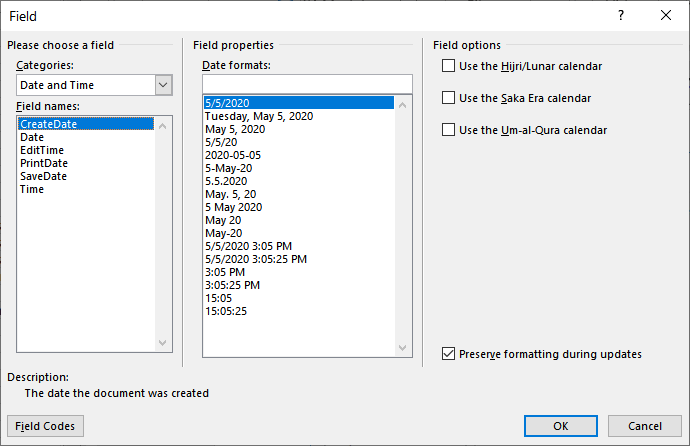Please Note: This article is written for users of the following Microsoft Word versions: 2007, 2010, 2013, 2016, 2019, and 2021. If you are using an earlier version (Word 2003 or earlier), this tip may not work for you. For a version of this tip written specifically for earlier versions of Word, click here: Inserting the Document Creation Date.
Written by Allen Wyatt (last updated November 7, 2024)
This tip applies to Word 2007, 2010, 2013, 2016, 2019, and 2021
Word keeps track of a good deal of information about your document, and then makes that information available to you. One of the pieces of information tracked is the document creation date. This is the date when the file was first created (opened as a new file) or the last time you chose Save As and saved the file under a new name. Word allows you to insert this date into your document by following these steps:

Figure 1. The Field dialog box.
This type of date field is a big help when you are using dates with memos, letters, and reports. The date stays the same as when you first created the file, unless (again) you save the file under a new name, which changes the file creation date.
WordTips is your source for cost-effective Microsoft Word training. (Microsoft Word is the most popular word processing software in the world.) This tip (9299) applies to Microsoft Word 2007, 2010, 2013, 2016, 2019, and 2021. You can find a version of this tip for the older menu interface of Word here: Inserting the Document Creation Date.

Create Custom Apps with VBA! Discover how to extend the capabilities of Office 365 applications with VBA programming. Written in clear terms and understandable language, the book includes systematic tutorials and contains both intermediate and advanced content for experienced VB developers. Designed to be comprehensive, the book addresses not just one Office application, but the entire Office suite. Check out Mastering VBA for Microsoft Office 365 today!
Word allows you to configure what you see so that field codes are visible instead of the results of those field codes. ...
Discover MoreIf you use fields to sum the information in your table columns, you might want to display a blank when the sum is zero. ...
Discover MoreOne of the most powerful and useful fields provided by Word is the SEQ field. This tip describes how you can use the ...
Discover MoreFREE SERVICE: Get tips like this every week in WordTips, a free productivity newsletter. Enter your address and click "Subscribe."
2024-11-07 08:30:46
Kiwerry
@dann: If you have a minute, please explain to non-archivists why saving the creation date of a file visibly inside a document is a problem; I am assuming that the date will be suitably labelled af "File creation date" or similar.
2021-04-11 01:49:05
dann
This feature is an Archivist's nightmare. If you work for a government agency or any other type of organisation that is legally required to keep historical records and documentation, do NOT do this.
Got a version of Word that uses the ribbon interface (Word 2007 or later)? This site is for you! If you use an earlier version of Word, visit our WordTips site focusing on the menu interface.
Visit the WordTips channel on YouTube
FREE SERVICE: Get tips like this every week in WordTips, a free productivity newsletter. Enter your address and click "Subscribe."
Copyright © 2026 Sharon Parq Associates, Inc.
Comments